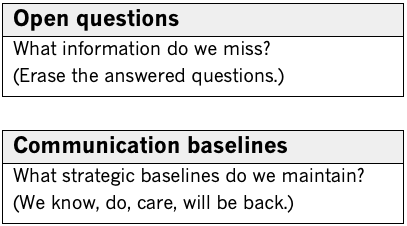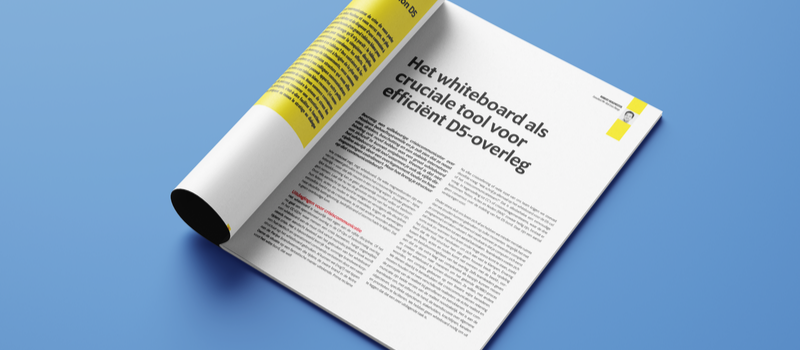After hundreds of crisis exercises and real activations for acute or smouldering crisis situations, Robbert wrote an article for Be Prepared explaining his favourite whiteboard layout and his reasoning behind it. With this article, we hope to accelerate the evolution towards a common recognised and used whiteboard structure for crisis communication teams. You can read the English translation below or download the original Dutch article at the end of the article.
Ask any crisis communicator what they need to thrive and you will notice that, next to food, water and a stable internet connection, a whiteboard will most likely be on that list. This should be no surprise: whiteboards are the tool to coordinate and guide crisis communication teams’ through meetings in stressful circumstances. But how do you structure this board for crisis communication?
No crisis room without some whiteboards. They are amongst the most used tools during crisis meetings, enabling crisis teams to build a better shared information picture about the situation at hand. Because without a shared information picture there cannot be a shared judgement, let alone decisions that everyone agrees with. This really is the biggest benefit of the whiteboard: by focusing on the board and letting everyone report their information, actions and needs, you are making sure that everyone is looking at the same traffic incident, industrial fire or storm damage. This is no luxury during crisis.
Challenges for crisis communication
Ofcourse the whiteboard is not exclusive for crisis communications teams. Whether it is an operational meeting in the Command Post or a strategic meeting in the Coordination Committee at the (local) government, there’s a whiteboard on the wall everywhere people are dealing with crisis. Also the individual Disciplines (eg. firefighters, police or medical services) are exploring new ways to use the whiteboard. It is truly fascinating to see how emergency services are using the whiteboard to improve their tactical and operational command. Some even go the extra mile by drawing the crisis situation, litterally creating a shared information picture, on the whiteboard. Consider for example the Parisian fire brigade, drawing the Notre Dame Cathedral in 3D during the fire early 2019. Quite the advertisement for the use of whiteboards, is it not?
After every crisis exercise or real intervention, people always ask us the same question: “What do you write on the crisis communication whiteboard?” That is no easy question. In contrast to operational or strategic teams, where the three colums Facts, Actions and Needs (FAN) are almost sacred, there is no concensus when it comes to the structure for the crisis communications whiteboard. This has multiple reasons.
We often have not enough mental space available in the brain when we experience stress. Compare it to a computer’s RAM-memory when it has to do lots of complex tasks at the same time. The computer then has to focus on a few basic tasks. Teamleaders also feel like this: when they experience a high amount of stress, their minds are, consciously or not, looking for handrails to cope with the situation. It is our experience that the famous FAN-method is not enough for them, mainly because the division between facts, actions and needs do not align with the different phases (seeing, judging, deciding; also known as SAD) of the crisis meeting. Teamleaders try to avoid adding complexity and therefore look for ways to use the same approach of seeing, judging and deciding on the board. In other words, they are trying to approach a complex meeting in a more structured and linear kind of way. In addition, we must emphasise that crisis communicators have to take into account two different realities: the real reality and the perception of that reality. Both are equally important for crisis communication. It is the Teamleader’s task to, with whiteboard markers in their hands, guide the team while discussing generic and specific objectives, stakeholders, communication baselines, channels and priorities. We do not need a whiteboard to explain how challenging this task is.
Dealing with complexity on the whiteboard
Our most used whiteboard layout is rooted in hundreds of trainings, exercises and real crisis activations. After lots of trial and error we have now finally established a whiteboard layout that helps us and our colleagues facilitate our crisis communication meetings.
The basic idea behind our most used whiteboard layout is that we use one big board to facilitate the process of seeing, judging and deciding on the crisis situation. Additionally, we use separate sheets to list the open questions and the strategic baselines (we know, we do, we care & we will be back, to be used by the team’s editors). The reason we do it this way is because we like to use the big whiteboard as a status board, while the loose sheets or flips display uncertainties (= open questions) and orders for the team’s editors (= strategic communication baselines). This enables teamleaders to approach meetings in a more linear way without completely ignoring its complexity. For example, to us it is a good practice to jot down open question on a separate sheet, so it does not interrupt the meeting too much, no matter when the question arises. We like to work in a similar way when it comes to discussing the communication baselines. By walking away from the status board to a separate flip, the Teamleader creates a distance, both physically in the meeting room and mentally in the heads of the participants. It makes it easier to get everyone in the right mindset to discuss communication content and, likewise, makes it easier to round up the discussion by returning to the status board.

On separate flip charts:

Towards a common (recognised) layout
Even though we find this whiteboard structure to be highly efficient, we have to make a couple of side notes. First we acknowledge that not every meeting room is equiped with whiteboards and flip charts. That is why we encourage teams to be creative so they can still use the basic principles as described earlier. Additionally, it is not our intention to force our proposed whiteboard structure on anyone, as we want people to remain flexible in times of crisis. Finally, the whiteboard can be compared to the layout of an office. Everybody likes their office organised in a certain way and we all have our reasons to do so. We do not all like the same way of organising and decorating. In a similar way, discussing the whiteboard layout can lead to endless discussions; one critical remark on someone’s whiteboard and you may find yourself in an endless discussion about color coding, columns, writing style, etc. In conclusion: our proposed layout is not sacred and we promote flexibility – also on the whiteboard.
By writing this article and spreading the word about our whiteboard structure for crisis communication, we hope to contribute to the long road towards a common, recognised structure. We are convinced that it will help reduce the stress levels of Teamleaders, so that they can pay even more attention to their core task: facilitating the functioning of their team in order to prepare the Strategist in the best possible way for their meetings with the policy team. Try our layout, play with it, adjust it and spread the word! We have a feeling that the Parisian fire brigade will start feeling the heat quite soon.
View article (Dutch)
Type: PDF, 84Kb
Language: Dutch
Source: Be Prepared, Issue 3/2019
This article is republished on our blog with permission of the editor Die Keure Publishing.
Note: we encourage you to share this blog post. Do refer to its page link and (please) don’t link straight to the PDF article when sharing.
